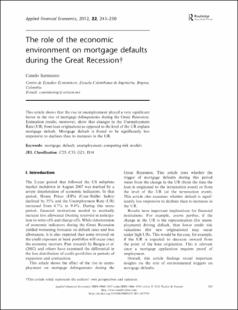Mostrar el registro sencillo del ítem
The role of the economic environment on mortgage defaults during the Great Recession
| dc.contributor.author | Sarmiento, Camilo | |
| dc.date.accessioned | 2023-08-23T16:36:31Z | |
| dc.date.available | 2023-08-23T16:36:31Z | |
| dc.date.issued | 2012 | |
| dc.identifier.issn | 0960–3107 | spa |
| dc.identifier.uri | https://repositorio.escuelaing.edu.co/handle/001/2590 | |
| dc.description.abstract | This article shows that the rise in unemployment played a very significant factor in the rise of mortgage delinquencies during the Great Recession. Estimation results, moreover, show that changes in the Unemployment Rate (UR; from loan origination) as opposed to the level of the UR explain mortgage default. Mortgage default is found to be significantly less responsive to declines than to increases in the UR. | eng |
| dc.description.abstract | Este artículo muestra que el aumento del desempleo jugó un factor muy importante en el aumento de la morosidad hipotecaria durante la Gran Recesión. Además, los resultados de la estimación muestran que los cambios en la Tasa de Desempleo (UR; desde la originación del préstamo) en contraposición al nivel de la UR explican el incumplimiento de las hipotecas. Se ha descubierto que el incumplimiento hipotecario responde significativamente menos a las caídas que a los aumentos en la RU. | spa |
| dc.format.extent | 8 páginas | spa |
| dc.format.mimetype | application/pdf | spa |
| dc.language.iso | eng | spa |
| dc.publisher | Routledge Taylor and Francis Group | spa |
| dc.source | http://www.tandfonline.com | spa |
| dc.title | The role of the economic environment on mortgage defaults during the Great Recession | eng |
| dc.type | Artículo de revista | spa |
| dc.type.version | info:eu-repo/semantics/publishedVersion | spa |
| oaire.accessrights | http://purl.org/coar/access_right/c_14cb | spa |
| oaire.version | http://purl.org/coar/version/c_970fb48d4fbd8a85 | spa |
| dc.contributor.researchgroup | Centro de Estudios Económicos | spa |
| dc.identifier.eissn | 1466–4305 | spa |
| dc.identifier.instname | Universidad Escuela Colombiana de Ingeniería Julio Garavito | spa |
| dc.identifier.reponame | Repositorio Digital | spa |
| dc.identifier.repourl | https://repositorio.escuelaing.edu.co/ | spa |
| dc.relation.citationedition | Vol. 22 de 2012 | spa |
| dc.relation.citationendpage | 250 | spa |
| dc.relation.citationstartpage | 243 | spa |
| dc.relation.citationvolume | 22 | spa |
| dc.relation.indexed | N/A | spa |
| dc.relation.ispartofjournal | Applied Financial Economics | eng |
| dc.relation.references | Adelino, M., Gerardi, K. S. and Willen, P. (2009) Why don’t lenders renegotiate more home mortgages? Redefaults, self-cures and securitization, NBER Working Paper Series No. 15159. | spa |
| dc.relation.references | Archer, W., Ling, D. and McGill, G. (1996) The effect of income and collateral constraints on residential mortgage terminations, Regional Science and Urban Economics, 26, 235–61. | spa |
| dc.relation.references | Bangia, A., Diebold, F. X. and Schuermann, T. (2002) Ratings migration and the business cycle, with application to credit portfolio stress testing, Journal of Banking and Finance, 26, 445–74. | spa |
| dc.relation.references | Bhutta, N., Dokko, J. and Shan, H. (2010) The depth of negative equity and mortgage default decisions, Finance and Economics Discussion Series: 2010-25, Board of Governors of the Federal Reserve System, Washington, DC. | spa |
| dc.relation.references | Capozza, D. and Thomson, T. (2006) Subprime transitions: lingering or malingering in default?, The Journal of Real Estate Finance and Economics, 33, 241–58. | spa |
| dc.relation.references | Deng, Y., Quigley, J. M. and van Order, R. (2000) Mortgage terminations, heterogeneity, and the exercise of mortgage options, Econometrica, 68, 275–307. | spa |
| dc.relation.references | Elul, R. (2009) Securitization and the mortgage default: reputation versus adverse selection, Working Papers No. 09-21, Federal Reserve Bank of Philadelphia. | spa |
| dc.relation.references | Fabozzi, F. J. (Ed.) (2006) Handbook of Mortgage-Backed Securities, 6th edn, McGraw-Hill, New York. | spa |
| dc.relation.references | Fair, R. C. and Shiller, R. J. (1990) Comparing information in forecasts from econometric models, American Economic Review, 80, 39–50. | spa |
| dc.relation.references | Foote, C. L., Gerardi, K., Goette, L. and Willen, P. S. (2009) ‘Reducing foreclosures, Public Policy Discussion Paper No. 09-2, Federal Reserve Bank of Boston | spa |
| dc.relation.references | Guiso, L., Sapienza, P. and Zingales, L. (2010) The determinants of attitudes towards strategic default on mortgages, Working Paper, University of Chicago Booth School of Business and Kellogg School of Management. | spa |
| dc.relation.references | Hillegeist, S. A., Keating, E. K., Cram, D. P. and Lundstedt, K. G. (2004) Assessing the probability of bankruptcy, Review of Accounting Studies, 9, 5–34. | spa |
| dc.relation.references | Hosmer, D. W., Lemeshow, S. and May, S. (2008) Applied Survival Analysis, 2nd edn, Wiley, New Jersey. | spa |
| dc.relation.references | O’Brien, R. M. (2007) A caution regarding rules of thumb for variance inflation factors, Quality and Quantity, 41, 673–90. | spa |
| dc.relation.references | Ronel, E., Souleles, N. S., Chomsisengphet, S., Glennon, D. and Hunt, R. (2010) What triggers mortgage default?, American Economic Review, 100, 490–4. | spa |
| dc.relation.references | Sarmiento, C. (2009) Regime changes in subprime margins under the US housing bubble, Applied Financial Economics, 19, 175–82. | spa |
| dc.rights.accessrights | info:eu-repo/semantics/closedAccess | spa |
| dc.subject.armarc | Recesiones económicas | |
| dc.subject.armarc | Crisis económica | |
| dc.subject.armarc | Desempleo | |
| dc.subject.armarc | Hipotecas | |
| dc.subject.armarc | Economic recessions | |
| dc.subject.armarc | Economic crisis | |
| dc.subject.armarc | Unemployment | |
| dc.subject.armarc | Mortgages | |
| dc.subject.proposal | Mortgage | eng |
| dc.subject.proposal | Default | eng |
| dc.subject.proposal | Unemployment | eng |
| dc.subject.proposal | Competing risk models | eng |
| dc.type.coar | http://purl.org/coar/resource_type/c_6501 | spa |
| dc.type.content | Text | spa |
| dc.type.driver | info:eu-repo/semantics/article | spa |
Ficheros en el ítem
Este ítem aparece en la(s) siguiente(s) colección(ones)
-
AG - Centro de Estudios Económicos [185]
Clasificación: C - Convocatoria 2018










